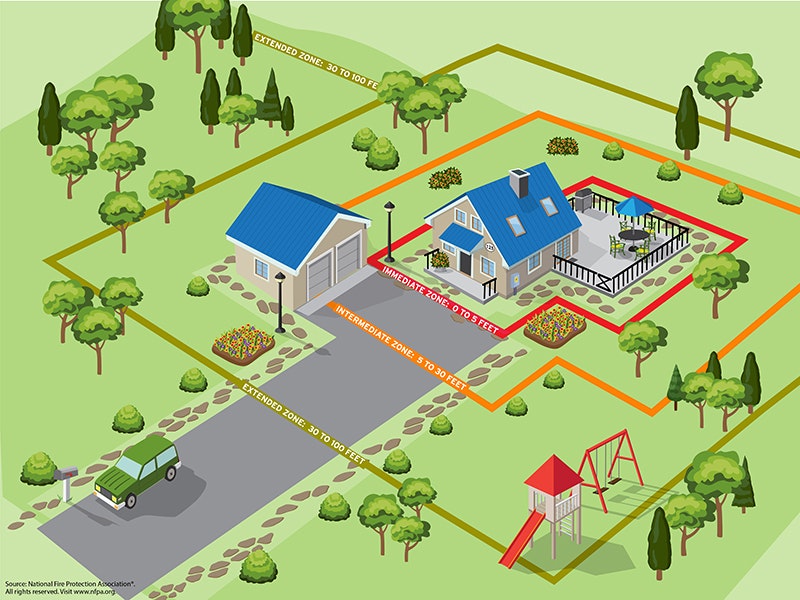Preparing Your Home Against Wildfire
Contact our Prevention Division at (928) 537-5100 for a Hazard Igniton Zone Assessment
Home Ignition Zones
The zones include:
- Immeditate Zone: 0-5 feet around the house
- Intermediate Zone: 5-30 feet
- Extended Zone: 30-100 feet

Landscaping and Maintenance
To reduce ember ignitions and fire spread, trim branches that overhang the home, porch, and deck and prune branches of large trees up to 6 to 10 feet (depending on their height) from the ground. Remove plants containing resins, oils, and waxes. Use crushed stone or gravel instead of flammable mulches in the Immediate Zone (0 to 5 feet around the house). Keep your landscape in good condition.
Fire Resistive Construction
Roofing and Vents
Class A fire-rated roofing products, such as composite shingles, metal, concrete, and clay tiles, offer the best
protection. Inspect shingles or roof tiles and replace or repair those that are loose or missing to prevent ember
penetration. Box in eaves, but provide ventilation to prevent condensation and mildew. Roof and attic vents should be screened to prevent ember entry.
Decks and Porches
Never store flammable materials underneath decks or porches. Remove dead vegetation and debris from under
decks and porches and between deck board joints.
Siding and Windows
Embers can collect in small nooks and crannies and ignitecombustible materials; radiant heat from flames can crack windows. Use fire-resistant siding such as brick, fibercement, plaster, or stucco, and use dual-pane tempered glass windows.
BE PREPARED
Emergency Responder Access
Ensure your home and neighborhood have legible and clearly marked street names and numbers. Driveways
should be at least 12 feet wide with a vertical clearance of 15 feet for emergency vehicle access.
- Develop, discuss, and practice an emergency action plan with everyone in your home. Include details for handling pets, large animals, and livestock.
- Know two ways out of your neighborhood and have a predesignated meeting place.
- Always evacuate if you feel it’s unsafe to stay—don’t wait to receive an emergency notification if you feel threatened from the fire.
- Conduct an annual insurance policy checkup to adjust for local building costs, codes, and new renovations.
- Create or update a home inventory to help settle claims faster.
Download HowToPrepareYourHomeForWildfires here.
FirewiseHowToPrepareYourHomeForWildfires.pdf
Other helpful information:
Wildfire Prepared Home, a Program of IBHS - Resources
VISIT NFPA - Firewise USA® FOR MORE DETAILS
